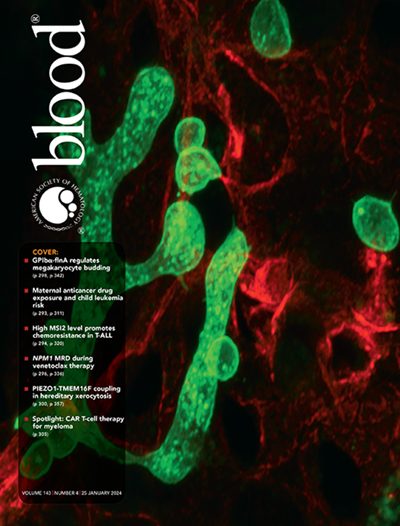DCAF8的缺失通过DOCK11-CDC42轴损害造血干细胞功能,导致细胞衰老。
IF 21
1区 医学
Q1 HEMATOLOGY
引用次数: 0
摘要
造血干细胞(hsc)负责维持整个生命中的造血系统,其功能下降有助于血液系统疾病和机体衰老。了解控制HSC功能的分子机制对于开发治疗和预防衰老相关疾病的干预措施至关重要。在这里,我们发现Cullin-RING E3泛素连接酶的底物识别成分DCAF8在造血干细胞中高度表达,并随着年龄的增长而逐渐下降。小鼠DCAF8缺失导致造血干细胞功能受损,其特征是细胞数量增加但自我更新能力下降,这与细胞衰老和DNA损伤升高有关。从机制上讲,DCAF8介导CDC42的鸟嘌呤核苷酸交换因子DOCK11的降解。在缺乏DCAF8的情况下,DOCK11积累,导致CDC42活性升高和相应的hsc极性丧失。敲除Dock11可减轻Dcaf8-/- hsc的衰老、DNA损伤和自我更新缺陷。本研究强调了DCAF8通过DOCK11-CDC42轴在预防HSC衰老中的关键作用,并提出了预防HSC功能下降的潜在治疗靶点。本文章由计算机程序翻译,如有差异,请以英文原文为准。
Loss of DCAF8 impairs hematopoietic stem cell function with cellular senescence via the DOCK11-CDC42 axis.
Hematopoietic stem cells (HSCs) are responsible for sustaining hematopoietic system throughout life, and their functional decline contributes to hematological disorders and organismal aging. Understanding the molecular mechanisms that govern HSC function is critical for developing interventions for treating and preventing aging-related diseases. Here, we show that DCAF8, a substrate recognition component of Cullin-RING E3 ubiquitin ligases, is highly expressed in HSCs and undergoes a progressive decline with age. Loss of DCAF8 in mice results in impaired function in HSCs, characterized by increased number yet decreased self-renewal capacity, which associates with cellular senescence and elevated DNA damage. Mechanistically, DCAF8 mediates the degradation of DOCK11, a guanine nucleotide exchange factor for CDC42. In the absence of DCAF8, DOCK11 accumulates, leading to elevated CDC42 activity and consequential loss of polarity of HSCs. Knocking out Dock11 mitigates the senescence, DNA damage, and self-renewal defects of Dcaf8-/- HSCs. This study highlights a critical role of DCAF8 in preventing HSC senescence via the DOCK11-CDC42 axis and suggests potential therapeutic targets for preventing functional decline in HSCs.
求助全文
通过发布文献求助,成功后即可免费获取论文全文。
去求助
来源期刊

Blood
医学-血液学
CiteScore
23.60
自引率
3.90%
发文量
955
审稿时长
1 months
期刊介绍:
Blood, the official journal of the American Society of Hematology, published online and in print, provides an international forum for the publication of original articles describing basic laboratory, translational, and clinical investigations in hematology. Primary research articles will be published under the following scientific categories: Clinical Trials and Observations; Gene Therapy; Hematopoiesis and Stem Cells; Immunobiology and Immunotherapy scope; Myeloid Neoplasia; Lymphoid Neoplasia; Phagocytes, Granulocytes and Myelopoiesis; Platelets and Thrombopoiesis; Red Cells, Iron and Erythropoiesis; Thrombosis and Hemostasis; Transfusion Medicine; Transplantation; and Vascular Biology. Papers can be listed under more than one category as appropriate.
 求助内容:
求助内容: 应助结果提醒方式:
应助结果提醒方式:


